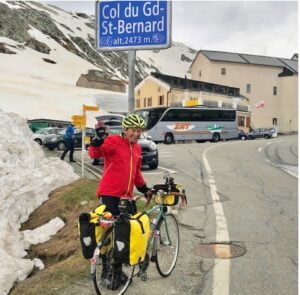Cycling the Via Francigena
This section covers the main issues for those pilgrims wanting to cycle the Via Francigena. It provides some basic information, and also gives references to books and websites that can supply more detail. We welcome feedback from cyclists.
Choice of Bike
If you are already an experienced cycling tourist you will have made your choice long ago. Newcomers may think of using a mountain bike or hybrid rather than one specifically designed for long distance cycle touring. Think carefully and take advice from friends, colleagues, local cycle clubs, and borrow or hire different types of bike to see which suits you. Type of handlebars (drops or straights), range of gears (range on rear cogs and double or triple chain ring on the front) and tyre type are the crucial choices. If you opt for a mountain bike do fit road tyres which will have less rolling resistance than off-road tyres. Make sure the cycle rack is strong and can be secured to the bike frame at four points. You will need a comfortable saddle – gel saddles offer good levels of comfort, and there are saddles designed specifically for women. Only by doing several long rides will you really know if your saddle suits you.
If buying a new bike, spend time looking in several shops, and if possible go to a reputable specialist dealer to discuss your needs with the experts in terms of daily distances you aim to travel, luggage weight you will carry, and the need for a good range of gears, particularly at the lower, for pedalling yourself and your luggage over steep hills, long mountain passes and into head winds. Make sure you fit a bell and lights. A good dealer will ensure you get the right size of bike and set up the handlebars and saddle to give you the best position for comfort and efficiency. Do not be tempted to go for the cheapest possible – you can buy a mountain bike for as little as £100-150 – but you will pay dearly in terms of pedalling a heavy machine with poor gear ratios and components. Talk with the dealer about what you want to achieve in terms of daily distance, amount of luggage you aim to carry, and your experience (or lack of it) of cycle touring.

Much also will depend on the distance you will cover, your route, the type of terrain and your plans and budget in terms of lodging or accommodation during the journey. If you are planning to cycle from Canterbury to Rome (nearly 2000 km) you need to consider you’ll be cycling for about a month or more. If you’re planning to camp, you’ll have to add to the weight of the bike the camping gear as well as a small kitchen and the typical requirements to sleep in a tent (sleeping bag appropriate for the time of the year, air mattress, etc). The overall setup is very much down to your budget as the lighter the equipment is, the more expensive it tends to be. This may result in having to equip your bike with a frontal rack for panniers as well as a rear one , that is four panniers in total (two in the back and two in the front).We strongly recommend a quick release handlebar bag for important documents (passport, IDs, etc) as well as your wallet and more expensive gadgets you may want to have an easy access to (cameras, mobile phone, etc). Think of weight distribution and centre of gravity. Consult more experienced cycle-tourers for advice. Try to avoid the temptation to carry anything you think you will not use and do a few “full-load” test rides of at least 30 km to make sure you’re comfortable with your setup, making adjustments if needed. Consider attaching a flag pole to the rear of the bike. Even if you don’t plan to ride at night, you may have to ride in windy, rainy and dark hours of the day. Being visible is extremely important even in bright daylight.
Bike Security
Secure locks can be both bulky and heavy. You need a compromise that will prevent opportunistic thefts but is reasonably light – a combination lock, for example. If you are going as a pair or in a larger group, each person can have a lightweight lock used to lock several bikes together, as well as at least one locked to an immovable object. Most hotels and hostels will have secure storage for bikes. If camping, there is usually some object close to your tent to lock the bike to. Failing that, tie a length of string to the bike with the other end tied to a tent pole: any attempt to move the bike will shake the tent and alert you!
If you are going alone, consider there will be moments in which you will need to lose line of sight from your bicycle to go to toilets or buy supplies at shops or supermarkets or even to obtain pilgrim stamps in churches, tourist information centres and other places. Many panniers tend have a quick release mounting system, which is intended to facilitate their removal, so one tip is to buy luggage straps at pound shops to tie the panniers to the rack (some will even come with a simple combination lock). They are not effective to protect your luggage for a long period of time but will add an extra level of difficult for opportunists for short moments.
Bike maintenance
At very least you need to carry the tools, and have the skills, to remove wheels and tyres, to change inner tubes, mend punctures, adjust brakes and possibly change brake pads. Find a friendly cyclist and ask to be shown how to carry out these tasks, and practise them until you are confident you can carry them out with reasonable efficiency. Carry a chain breaker, spare chain links, spare spokes and spoke spanner. Even if you can’t use them yourself many other cyclists will be able to, and most would stop to offer assistance if they see you in difficulty or stranded. There are many good basic bike maintenance guides and it is fairly easy to find classes in basic cycle maintenance and repairs.
Bags and Panniers
Purchase good quality panniers that are waterproof and have strong fastenings that will keep them locked firmly onto the bike. Get a handlebar bag that can be easily unclipped and has a map case attached to the top as this will make route finding easier, and allow you easy access to sun block, food, glasses and other essentials on the journey. Do not carry too much stuff – your first practice ride with a fully loaded bike may help focus your mind on what is essential, and what you can leave out to lighten your load. The author of this article never uses front wheel panniers, even when camping, as everything can be fitted into a handlebar bag and two rear panniers with just the tent and sleeping mat strapped on the top of the carrier. Any cycle touring book will offer advice about lightweight camping equipment and suitable clothing.
Clothes
Make sure you have several pairs of padded shorts or underwear to allow a daily change and time for drying. A high standard of personal hygiene is vital if you are to avoid a sore backside when cycling significant distances on a daily basis – a daily shower and change of padded shorts. A small first aid kit with non-stick dressings, a bandage, Elastoplasts, antiseptic creams, Vaseline and pain killers is essential. E45 cream is a useful all-purpose cream to soothe sore skin, and rehydrate areas exposed to the sun. There are good brands of Chamois cream that prevent soreness. While using padded cycling trousers / shorts (lycra), don’t use any underwear while cycling long distances for long hours as they will cause friction and irritate the skin.
Use a neutral, all purpose, soap that you can bathe and wash your clothes with.
Cycling gloves or mittens provide extra padding for your hands on roads with bad surfaces. As well as a good quality waterproof and windproof jacket, make sure you have enough clothes to wear several layers in wet/windy/cold weather. There are several high mountain passes to cycle over and even in summer time it can be cold in the Jura Mountains, the Alps and Apennines. Remember to carry some clothes appropriate for visiting churches – many have dress codes and will not let you in wearing shorts or sleeveless tops.
Health and Fitness
Cycling such a long distance as Canterbury to Rome needs determination, resilience and fitness. Whilst cycling 40-80 miles a day as a one-off is not too difficult, maintaining the effort most days for three weeks is much harder, unless you have developed a good level of fitness before you start your pilgrimage. You need to cycle at least twice a week for some months before your start date. Over a period of a few weeks, work up to your expected daily distance, and then go out several times to cover this distance with fully-packed panniers. Use the bike and clothes you will use for your pilgrimage to iron out any problems. If in doubt as to your general health seek the advice of your GP. Swimming, walking and running will all improve your general fitness levels as you prepare for your journey and, if winter weather prevents outdoor cycling, many gyms have bike machines. Home trainers which fit your own bike are now reasonably priced. You will enjoy your journey so much more if you are not permanently exhausted. Be realistic in your daily distance target and put some rest days into your schedule.
General Safety Points
Purchase – and always wear – a good quality helmet. It can make all the difference between minor injuries and a major trauma if you come off your bike, or are knocked off by traffic. Sunglasses are essential in bright sun, and regular use of sun-block will help avoid painful skin conditions caused by sunburn. If coming from the UK cycling on the right can cause problems – first thing in the morning, for example, or when starting after a break and there is no other traffic about. Be vigilant at all times for traffic coming from side roads, for potholes and loose surface gravel.
If you like to listen to music while cycling or may have the need to take or make phone calls during the ride, consider using bone conduction headphones which will free your ears and allow to enjoy your music without blocking ambient noise as your ears are nor covered or blocked by conventional headphones.
Maps and routes:
Google Maps will provide cycling specifically directions in the UK and France. Technology will help a lot and it is part of modern pilgrimage, yet a low tech or offline “fall-back” option is advisable as technology can fail where paper cannot.
In Italy the Via Francigena cycle route is well way-marked in blue and white, as shown (right).
Websites, books and apps
European Association of the Via Francigena website
https://www.lifeintravel.it/cicloturismo.html
EuroVelo 5 London-Brindisi www.eurovelo.com via Rome, provides a cycle route although it deviates from the Via Francigena.
The Rhône valley cycle route www.en.viarhona.com covers the route from Lausanne to Martigny, mainly on dedicated cycle tracks
Cycle touring club www.ctc.org.uk has a great deal of information and advice on its website. Good for tips on equipment, safety and insurance at very good rates
The Bike Book – Complete bicycle maintenance, Milson. F. (2013) Haynes Publishing Yeovil, UK.
Apps
Via Francigena App(also from iOS)
Francigena Ways App (also from iOS)
DorMI ToPo FRancigena I App (also from iOS)
Blogs
https://kevinandlinda4.wordpress.com
https://rishiandbenridebikes.blogspot.com/au
https://www.harlechjoe.wordpress.com

About the Author
Paulo Seth
This section has been revised and updated by CPR member and experienced distance cyclist, Paulo Seth, who wrote a blog on cycling the Via Francigena.

